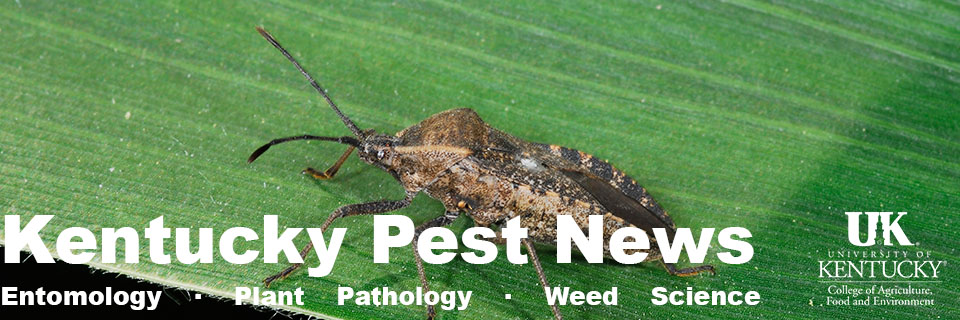Powdery Mildew Powdery mildew is being observed in some wheat fields in the state (Figure 1). My general historical observations of powdery mildew of wheat in Kentucky have been limited, with very few observations in commercial fields over the past…
Blog Archives
Pre- and Post-emergence Strike of Slugs & Snails on Soybeans
Abundance of Slugs & Snails in 2024 The warmer winter in 2024, along with rains and foggy conditions during several days in March and April, have been conducive to the presence of slugs and snails in commercial and research plots…
Wheat Disease Update: Fusarium Head Blight & Stripe Rust
Fusarium Head Blight (FHB) Several wheat fields in Kentucky are now at the anthesis stage (Feekes 10.51, “flowering”) or fast approaching it. Anthesis is a critical time as wheat becomes susceptible to infection by Fusarium graminearum, the primary causal agent of…
True Armyworm Moth Captures Increasing in Central Kentucky
This past week, the numbers of true armyworm moths continued to increase in traps in Fayette County; the count reached 269 moths per trap for the week. This is a different species from the fall armyworm that had an outbreak…
Register now for “Scabinar 2024” — a Free National Webinar on Fusarium Head Blight (Scab) of Small Grain Crops
A free national webinar event focused on Fusarium head blight (also known as “scab”) of small grain crops, known as “Scabinar,” will be held on March 13, 2024, at 10:00 AM – 12:00 PM Central Time (11:00 AM – 1:00…
Slugs are Active in February 2024, but Farmers Have Two Registered Molluscicides under Section 24(c) in Kentucky
Current Conditions In 2023, slugs were almost absent in most field crops in Kentucky due to environmental conditions severe drought and temperatures higher than 75o F). Lately, rainy days and cold temperatures that alternate with record highs have provided ideal…
2024: First Scout for Aphids, then Conduct an Early Spray if Aphids are above Thresholds in Winter Wheat
Aphids in Wheat Several aphid species are key pests in small grains (wheat, barley, and cereal rye) in Kentucky for their role as vectors of barley yellow dwarf virus (BYDV). Among them, bird cherry oat and English grain aphids overwinter…
November Weather is Suitable for Aphid Feeding & Virus Transmission on Wheat
Current Conditions In Kentucky, small grain cereals, including wheat and barley, are planted after the fly-free dates established for the Hessian fly. These dates are October 4 and October 15 for the northernmost and southernmost latitudes of Kentucky, respectively. Since…
Management of Soybean Cyst Nematode Starts with Soil Sampling this Fall
The soybean cyst nematode (SCN) (Figure 1) causes greater annual yield losses in Kentucky than any other pathogen of soybean. Preliminary results from an on-going SCN survey initiated in 2019 show that approximately 80% of Kentucky fields are infested with…
First Confirmation of Tar Spot on Kentucky Corn in 2023
Tar spot on corn was confirmed by the University of Kentucky Plant Disease Diagnostic Laboratory (PDDL) from samples collected in Caldwell County on September 7. This is the first confirmation of tar spot in Kentucky in 2023. So far, this…
Three-Cornered Alfalfa Hopper in Alfalfa
Last week, UK Extension Entomologists had reports of high numbers of three-cornered alfalfa hopper (TCAH) on alfalfa in Meade County. This insect can be an occasional pest of both alfalfa and soybeans, but rarely gets to economically damaging levels. While…
Status of Insect Pests in Soybeans in August 2023
Current Conditions This growing season, it has been quiet in terms of insect presence in Kentucky soybeans, at least up until mid-August 2023. However, while scouting for insect pests August 14 to August 18, a couple of insects may be…
Southern Rust in Corn: A Late Season Confirmation
Southern rust of corn, caused by the fungus Puccinia polysora, was confirmed in Kentucky on August 8, in Todd County. As of August 14, the Plant Disease Diagnostic Laboratory has confirmed the disease in several counties across the state. With…
Soybean Diseases & Disorders with Interveinal Chlorosis Symptoms on Leaves
Symptoms of soybean leaves with interveinal chlorosis and interveinal necrosis have been observed in fields across Kentucky recently. Interveinal chlorosis/necrosis is when the leaf tissue between the main leaf veins turns chlorotic (yellow) or necrotic (brown/dead), but the main veins…
Conditions Favorable for Phytophthora Root & Stem Rot of Soybean in Some Areas of Kentucky
Warm and wet weather that has been present in parts of Kentucky recently has been favorable for Phytophthora root and stem rot of soybean. Especially in soil types that drain slowly or in low-lying areas of fields, Phytophthora root rot…
